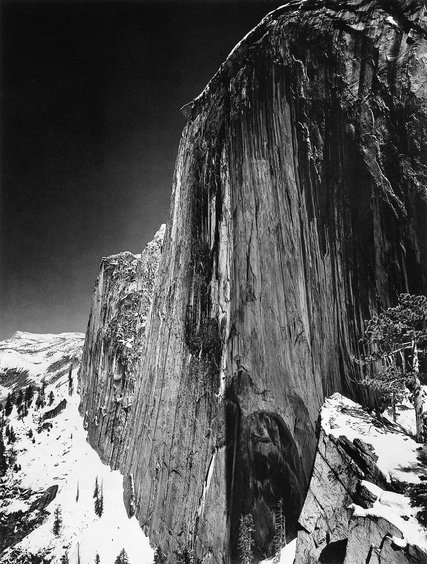Research – Photographers and Artists
Ansel Adams (1901-1984):
Famous for black and white wilderness photos, and membership of club f64, the name of the group is taken from the smallest setting of a large-format camera diaphragm aperture that gives particularly good resolution and depth of field.
The group believed in the “innate honesty” of the camera, which, as Weston described, “should be used for a recording of life, for rendering the very substance and quintessence of the thing itself, whether it be polished steel or palpitating flesh.” The f/64 photographers were concerned with natural subjects—Weston’s evocative close-ups of fruits and vegetables, for example, or Adams’s sublime images of Yosemite National Park, nudes, and everyday objects. In their 1932 manifesto, Group f/64 described pure photography as “possessing no qualities of technique, composition, or idea derivative of any other art form,” a conviction very much in line with modernism’s celebration of the intrinsic qualities of each medium—paintings should be painterly, photographs should be photographic, and sculptures should be sculptural.
https://www.artsy.net/article/theartgenomeproject-how-ansel-adams-and-the-photography-group
and teaching the ‘zone system‘, which is a way of calculating perfect exposure no matter what the conditions. It mostly related to film photography but could be used in digital photography.

Half Dome, Ansel Adams (1927)
Fay Godwin (1931-2005)
British photographer, used her images to campaign for conservation of the british countryside. Mostly used deep focus
Godwin’s exceptional body of work, her outspoken personality and her genuine concern for the environment made her a unique figure in British photography. Her unpretentious attitude to photography and her devotion to the landscape are captured in this quote from one of her final interviews, with journalist David Corfield in 2004:
‘I don’t get wrapped up in technique and the like,’ she said. ‘I have a simple rule and that is to spend as much time in the location as possible. You can’t expect to take a definitive image in half an hour. It takes days, often years. And in fact I don’t believe there is such a thing as a definitive picture of something. The land is a living, breathing thing and light changes its character every second of every day. That’s why I love it so much.’
Read more at http://www.amateurphotographer.co.uk/technique/fay-godwin-1931-2005-iconic-photographer-18907#R7eEhF4wpR6vAmlv.99
images by Fay Godwin – really like the atmosphere created and the depth created by having a focal point in the foreground which leads the eyes into the image.
Gianluca Cosci
Gianluca’s work seems a complete opposite from Ansel Adams and Fay Godwin’s. He uses very shallow depths of field and shows us very limited views of his subjects.
Standardisation is a tool of control and constraint of people into reassuring and harmless psychological and architectural boxes in which any hint of improbable rebellion would be easily sedated.
My work tries to suggest these ideas showing sanitised office blocks, censored landscapes and lifeless environments. With my photographs I would like to insinuate a subtle sense of violence in our deeply hierarchical society. I am interested in the point of view of the loser, the marginalised.
Often we are forced to have only restricted views, uncomfortable to maintain. In spite of this, I believe that one can take advantage of this apparent fault and use it to observe and understand things in a different, unexpected way.
Gianluca Cosci, 2006
In his interview with Kevin Byrne in April 2016, Gianluca says “G.C.: I don’t really consider myself a “photographer” rather an artist without a defined, strict identity… “
He seems to have a real issue with capitalism and the immense wealth of a few. I think by denying us the full view of their creations he is pouring doubt on their achievements and giving us a more abstract art where we can interpret it how we wish. This may stem from his roots in small town Bologna in Italy where wealth and power may be less obvious. Is this a visual interpretation of his own feelings of self worth or pushing the viewer to think freely?
These 3 photographers had different viewpoints
- Ansel Adams – the pure wonder of nature
- Fay Godwin – mans effect of the beauty of nature
- Gianluca Cosci – Manmade creations and their link with power and suppression of free thinking
Mona Kuhn:
As soon as I saw Mona’s images, I absolutely connected with them, I love the imagery, and colouration. The soft creams and browns coupled with the duel exposures of looking through the windows at her subjects. She has used a fairly shallow depth of field which gives a soft dreamy look.
This is something I’ve tried a lot in my own work, so definitely something I would like to emulate and take forward.
Kim Kirkpatrick:
just 5 photos!!! very shallow depth of field, in industrial landscapes not very inspiring to me.
Guy Bourdin (1928 – 1991)
Guy Bourdin, was a French artist and fashion photographer known for his provocative images. From 1955, Bourdin worked mostly with Vogue as well as other publications including Harper’s Bazaar.
All of Guy’s photos are sharp throughout and yet still have a very graphic and artistic quality.
web references:
- https://www.artsy.net/article/artsy-editorial-photograph-made-ansel-adams-famoushttps://photography.tutsplus.com/tutorials/understanding-using-ansel-adams-zone-system–photo-5607
- http://www.amateurphotographer.co.uk/technique/fay-godwin-1931-2005-iconic-photographer-18907
- https://www.widewalls.ch/10-landscape-photographers/ansel-adams-2/
- http://www.gianlucacosci.com/page15.htm
- http://www.monakuhn.com/
- http://www.kimkirkpatrick.com/Artist.asp?ArtistID=23660&Akey=FGWAF5R9&ajx=1#!pf97163
- http://www.tate.org.uk/art/artists/guy-bourdin-13592
















